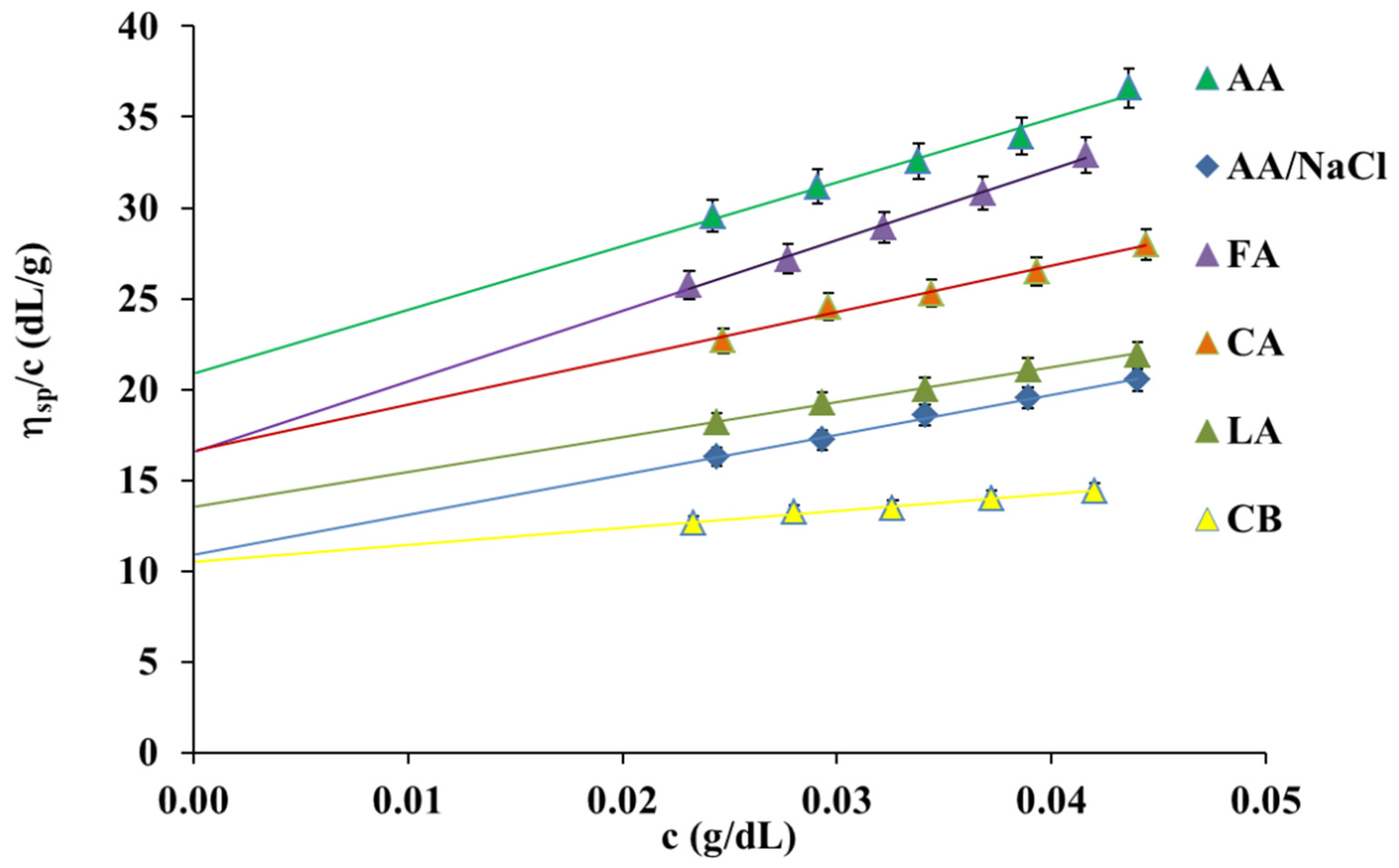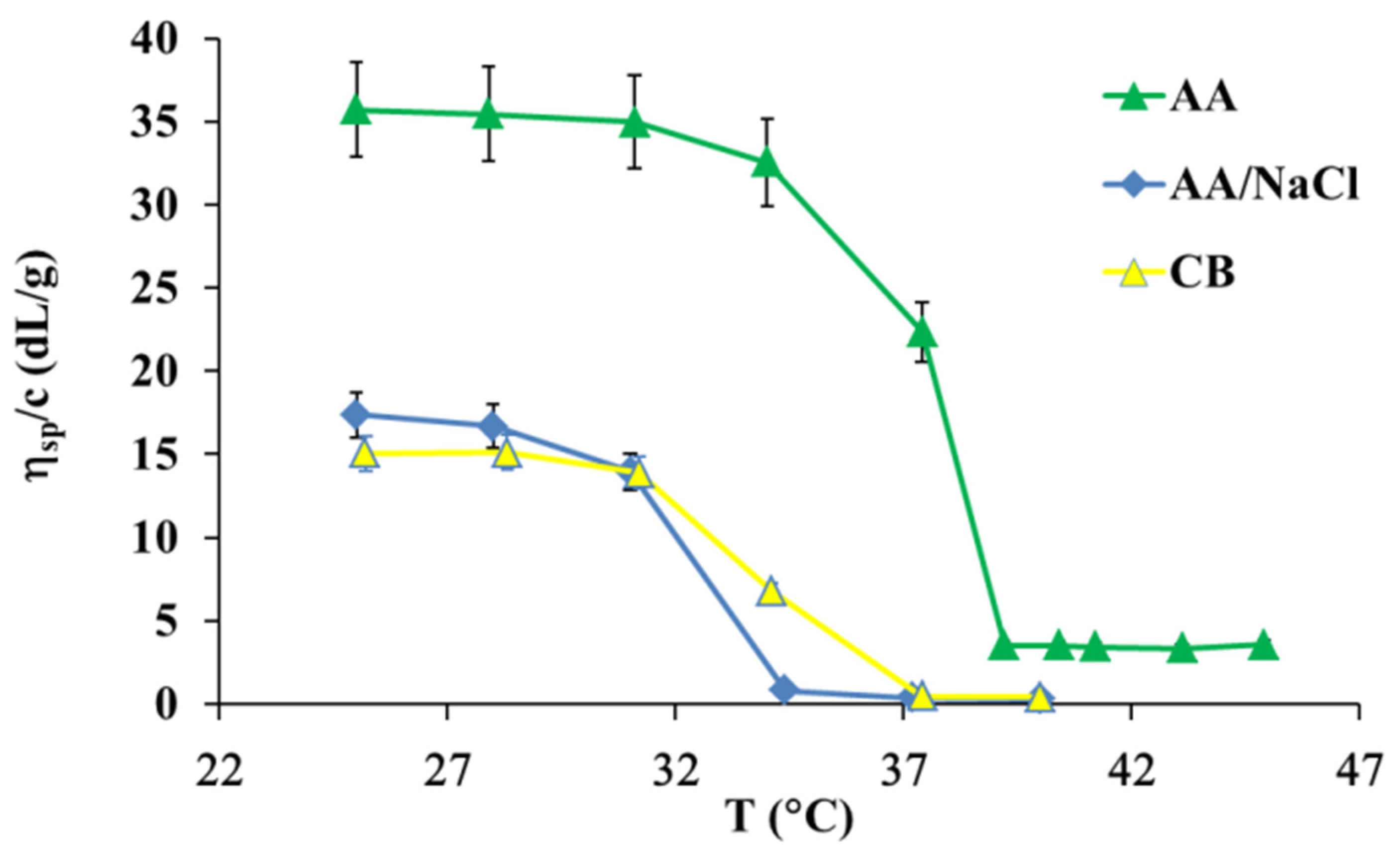Effect of Solvent on the Hydrodynamic Properties of Collagen
Abstract
:1. Introduction
2. Materials and Methods
2.1. Materials
2.2. Solution Preparation
2.3. Viscometric Method
2.4. Determination of Denaturation Temperature by Viscometric Method
2.5. UV Irradiation of Dilute Collagen Solutions
3. Results and Discussion
3.1. Viscometric Studies
3.2. Determination of Denaturation Temperature by Viscometric Method
3.3. Influence of UV Irradiation on Dilute Collagen Solutions
4. Conclusions
Author Contributions
Funding
Data Availability Statement
Conflicts of Interest
References
- Sionkowska, A. Current research on the blends of natural and synthetic polymers as new biomaterials: Review. Prog. Polym. Sci. 2011, 36, 1254–1276. [Google Scholar] [CrossRef]
- Li, Y.; Li, Y.; Du, Z.; Li, G. Comparison of dynamic denaturation temperature of collagen with its static denaturation temperature and the configuration characteristics in collagen denaturation processes. Thermochim. Acta 2008, 469, 71–76. [Google Scholar] [CrossRef]
- Oliveira, V.M.; Assis, C.R.D.; Costa, B.A.M.; Neri, R.C.A.; Monte, F.T.D.; Freitas, H.M.S.C.V.; França, R.C.P.; Santos, J.F.; Bezerra, R.S.; Porto, A.L.F. Physical, biochemical, densitometric and spectroscopic techniques for characterization collagen from alternative sources: A review based on the sustainable valorization of aquatic by-products. J. Mol. Struct. 2021, 1224, 129023. [Google Scholar] [CrossRef]
- Carvalho, A.M.; Marques, A.P.; Silva, T.H.; Reis, R.L. Evaluation of the potential of collagen from codfish skin as a biomaterial for biomedical applications. Mar. Drugs 2018, 16, 495. [Google Scholar] [CrossRef] [PubMed] [Green Version]
- Wei, P.; Zheng, H.; Shi, Z.; Li, D.; Xiang, Y. Isolation and characterization of acid-soluble collagen and pepsin-soluble collagen from the skin of hybrid sturgeon. J. Wuhan Univ. Technol. Sci. Ed. 2019, 34, 950–959. [Google Scholar] [CrossRef]
- Pachence, J.; Berg, R.; Silver, F. Collagen: Its place in the medical device industry. Med. Device Diagn. Ind. 1987, 9, 49–55. [Google Scholar]
- Sionkowska, A.; Skrzyński, S.; Śmiechowski, K.; Kołodziejczak, A. The review of versatile application of collagen. Polym. Adv. Technol. 2016, 28, 4–9. [Google Scholar] [CrossRef]
- Sionkowska, A.; Adamiak, K.; Musiał, K.; Gadomska, M. Collagen based materials in cosmetic applications: A review. Materials 2020, 13, 4217. [Google Scholar] [CrossRef]
- Lai, G.; Li, Y.; Li, G. Effect of concentration and temperature on the rheological behavior of collagen solution. Int. J. Biol. Macromol. 2008, 42, 285–291. [Google Scholar] [CrossRef]
- Yang, H.; Duan, L.; Li, Q.; Tian, Z.; Li, G. Experimental and modeling investigation on the rheological behavior of collagen solution as a function of acetic acid concentration. J. Mech. Behav. Biomed. Mater. 2018, 77, 125–134. [Google Scholar] [CrossRef]
- Nagai, T.; Worawattanamateekul, W.; Suzuki, N.; Nakamura, T.; Ito, T.; Fujiki, K. Isolation and characterization of collagen from rhizostomous jellyfish (Rhopilma asamushi). Food Chem. 2000, 70, 205–208. [Google Scholar] [CrossRef]
- Sionkowska, A. Interaction of collagen and poly(vinyl pyrrolidone) in blends. Eur. Polym. J. 2003, 39, 2135–2140. [Google Scholar] [CrossRef]
- Lewandowska, K. The miscibility of poly (vinyl alcohol)/poly (N-vinylpyrrolidone) blends investigated in dilute solutions and solids. Eur. Polym. J. 2005, 41, 55–64. [Google Scholar] [CrossRef]
- Usha, R.; Jaimohan, S.M.; Rajaram, A.; Mandal, A.B. Aggregation and self assembly of non-enzymatic glycation of collagen in the presence of amino guanidine and aspirin: An in vitro study. Int. J. Biol. Macromol. 2010, 47, 402–409. [Google Scholar] [CrossRef] [PubMed]
- Zenga, S.; Yin, J.; Yang, S.; Zhang, C.; Yang, P.; Wu, W. Structure and characteristics of acid and pepsin-solubilized collagens from the skin of cobia (Rachycentron canadum). Food Chem. 2012, 135, 1975–1984. [Google Scholar] [CrossRef]
- Sionkowska, A.; Kaczmarek, B.; Lewandowska, K. Modification of collagen and chitosan mixtures by the addition of tannic acid. J. Mol. Liq. 2014, 199, 318–323. [Google Scholar] [CrossRef]
- Sionkowska, A.; Lewandowska, K.; Michalska, M.; Walczak, J. Characterization of silk fibroin 3D composites modified by collagen. J. Mol. Liq. 2016, 215, 323–327. [Google Scholar] [CrossRef]
- Huggins, M.H. The viscosity of dilute solutions of long-chain molecules. IV Dependence on concentration. J. Am. Chem. Soc. 1942, 64, 2716–2718. [Google Scholar] [CrossRef]
- Bohdanecký, M.; Kovář, I. Viscosity of Polymer Solution; Jenkins, A.D., Ed.; Elsevier Science: Amsterdam, The Netherlands, 1982; Volume 2, pp. 167–186. [Google Scholar]
- Huppenthal, L. Polymer Solutions, 1st ed.; Nicolaus Copernicus University: Torun, Poland, 2016; pp. 159–200. [Google Scholar]
- Nishihara, T.; Doty, P. The sonic fragmentation of collagen macromolecules. Biochemistry 1958, 44, 411–417. [Google Scholar] [CrossRef] [Green Version]
- Zhu, P.; Yang, H.; Wang, S. Viscosity behaviour of poly-ε-caprolactone (PCL)/poly(vinyl chloride) (PVC) blends in various solvents. Eur. Polym. J. 1998, 34, 91–94. [Google Scholar]
- Lewandowska, K.; Staszewska, D.U.; Bohdanecky, M. The Huggins viscosity coefficient of aqueous solution of poly (vinyl alcohol). Eur. Polym. J. 2001, 37, 25–32. [Google Scholar] [CrossRef]
- Shoulders, M.D.; Raines, R.T. Collagen structure and stability. Annu. Rev. Biochem. 2009, 78, 929–958. [Google Scholar] [CrossRef] [PubMed] [Green Version]
- Grønlien, K.G.; Pedersen, M.E.; Sanden, K.W.; Høst, V. Collagen from Turkey (Meleagris gallopavo) tendon: A promising sustainable biomaterial for pharmaceutical use. Sustain. Chem. Pharm. 2019, 13, 100166. [Google Scholar] [CrossRef]
- Usha, R.; Ramasami, T. The effects of urea and n-propanol on collagen denaturation: Using DSC, circular dicroism and viscosity. Thermochim. Acta 2004, 409, 201–206. [Google Scholar] [CrossRef]
- Sionkowska, A.; Lewandowska, K.; Adamiak, K. The Influence of UV Light on Rheological Properties of Collagen Extracted from Silver Carp Skin. Materials 2020, 13, 4453. [Google Scholar] [CrossRef]



| Solvent | [η] dL/g | kH | R2 |
|---|---|---|---|
| AA | 20.90 ± 0.90 | 0.80 | 0.992 |
| AA/NaCl | 10.88 ± 0.34 | 1.87 | 0.997 |
| FA | 16.55 ± 0.45 | 1.42 | 0.998 |
| CA | 16.58 ± 0.64 | 0.93 | 0.993 |
| LA | 13.83 ± 0.16 | 0.96 | 0.999 |
| CB | 10.52 ± 0.19 | 0.84 | 0.995 |
Publisher’s Note: MDPI stays neutral with regard to jurisdictional claims in published maps and institutional affiliations. |
© 2021 by the authors. Licensee MDPI, Basel, Switzerland. This article is an open access article distributed under the terms and conditions of the Creative Commons Attribution (CC BY) license (https://creativecommons.org/licenses/by/4.0/).
Share and Cite
Lewandowska, K.; Szulc, M.; Sionkowska, A. Effect of Solvent on the Hydrodynamic Properties of Collagen. Polymers 2021, 13, 3626. https://doi.org/10.3390/polym13213626
Lewandowska K, Szulc M, Sionkowska A. Effect of Solvent on the Hydrodynamic Properties of Collagen. Polymers. 2021; 13(21):3626. https://doi.org/10.3390/polym13213626
Chicago/Turabian StyleLewandowska, Katarzyna, Marta Szulc, and Alina Sionkowska. 2021. "Effect of Solvent on the Hydrodynamic Properties of Collagen" Polymers 13, no. 21: 3626. https://doi.org/10.3390/polym13213626
APA StyleLewandowska, K., Szulc, M., & Sionkowska, A. (2021). Effect of Solvent on the Hydrodynamic Properties of Collagen. Polymers, 13(21), 3626. https://doi.org/10.3390/polym13213626








